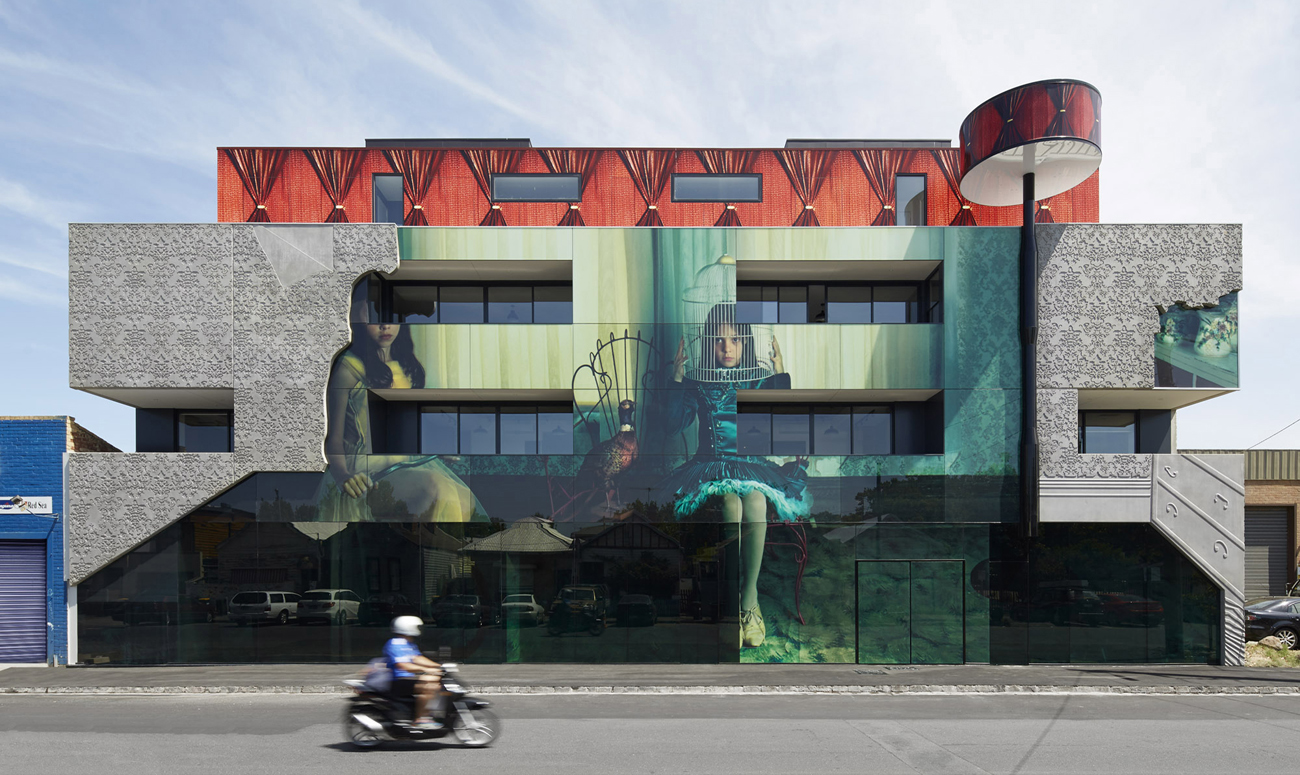
Building 2 Girls Building in Melbourne blurs the lines between architecture and art
 |
The 2 Girls Building offers a new perspective on the role of art in architecture. An artistic photo portrait of two girls covers the glass façade of the building. The wallpaper pattern in the background merges into the patterned concrete of the facade. A lamp has been transformed into a three-dimensional object that grows out of the image and actually illuminates. The 2 Girls Building combines sculpture, construction, and visuality in a way that allows art and architecture to overlap.
This building, located in the industrial district of Abbortsford in Melbourne, is truly unmissable. This area is home to the Carlton and United Brewery, which adds a hoppy aroma to the surrounding air. Over the past several years, many industrial buildings in this promisingly developing area have been transformed into residential properties. Property prices have been rising since the new millennium. The urban design of the 2 Girls Building references numerous industrial buildings, while sharply contrasting with the surrounding properties. The 2 Girls Building, which is flanked by cozy homes, overlooks a sports field and a nearby school.


The client, Domain Hill, wanted to construct a quality residential property while also making an aesthetic impression. The façade was to be designed based on a photograph on glass. Hill asked the architect to use DigiGlass technology, as the company is a 50 percent shareholder in the manufacturing plant.
THE VIEWER IS ALMOST ABSORBED
Architect Billy Kavellaris from the Australian firm Kavellaris Urban Design (KUD), who was already familiar with the material for the façade, had to approach the assignment creatively. He decided to decorate the façade with a work by Australian artist Samantha Everton. The choice fell on a photograph titled "Masquerade" from her series "Vintage Dolls," which captures the two daughters of the developer. The girls are sitting in a room with opulent wallpaper and a decorative carpet next to a standing lamp and a vanity. One of the girls sits on a tricycle while her sister sits on a metal chair next to a stuffed bird and is wearing a birdcage on her head.

Photographer Samantha Everton feels honored to have her photograph selected. However, she was concerned about the transformation of the two-dimensional image into a three-dimensional structure. "My work is large enough to cover the viewer's field of vision and evoke a sense that they can step into the photograph. The 2 Girls Building took it to the next level," Everton revealed. The viewer is almost absorbed by the size of the image and the different levels, further supported by the use of glass and concrete.
The image had to be modified to align the photograph with the "canvas of the building." "Masquerade was thus transferred from its original context. Considerable care was required to ensure the image retained its integrity in the new form," Everton said. Meeting with Kavellaris alleviated her concerns about the outcome, as both share a meticulous sense of detail.
THE FAÇADE IS PART OF THE IMAGE
The DigiGlass technology created a particularly realistic effect with intense colors. The high-resolution color photograph was placed between two layers of safety glass. The photograph spans an area of approximately 185 square meters and is divided into 36 glass panels that were mounted on site seamlessly.

The requirement for a photographic façade necessitated an interdisciplinary approach. It quickly became clear to architect Bill Kavellaris that the façade should not only frame the image but should become part of it. He wanted to combine art with architecture through a single medium.
The first step was the wallpaper. The pattern was to continue onto the concrete surface of the façade. The concrete needed to undergo patterning. KUD sent a 2D CAD file of the design to RECKLI. Australian technicians created a file for the CNC machine from this drawing and manufactured a model measuring 500 by 500 millimeters with a 10-millimeter deep pattern and a ten percent taper. The depth of the pattern and the taper were particularly important to Kavellaris, as he needed to create a shadow effect. RECKLI provided the precast concrete supplier SA Precast with four individual polyurethane molds with a 10-millimeter deep pattern. The almost perfectly smooth connection of the finished concrete façade to the surface of the DigiGlass is quite impressive.
Secondly, Kavellaris added a third material to the glass covering the photograph and the patterned concrete. The top part of the building was to be clad with Vitra panels depicting heavy, red curtains—a pattern that is also present on the standing lamp. Thirdly, Everton and Kavellaris decided to make the lamp an integral part of the building. In the final design, the lamp emerges from the image and becomes a three-dimensional object. The integrated lighting also serves as an actual fixture, allowing the building to glow in the dark and giving the photograph a completely new atmosphere. "I love how the lamp conveys the idea of Masquerade. There is truly a connection between the image and the building," Everton stated.
A VERY ARTISTIC APPROACH
The interdisciplinary collaboration between the architect and the artist allowed for the crossing of boundaries between these professions. Everton sees unity in the way the project was carried out as a whole. She claims that when it comes to art and architecture, it is imperative to understand every aspect of technical implementation and artistic execution and to be able to harmoniously integrate them. Kavellaris summarizes the project with the words: "The architect becomes an artist and vice versa." As a result, he believes it is a new medium... an art house.Both the artist and the architect maintained a purely artistic approach, which was also reflected in the interior of the building and winds through all four levels. Kavellaris's idea that the building should serve as a permanent art gallery led to the space being accessible to photography students, who can exhibit their works here before graduating.
The interior certainly resembles a gallery - ceilings are up to 3 meters high, and corridors and staircases about 2.5 meters wide guide visitors through various exhibitions in the building. Particularly the wide corridors give the building an air of a luxurious gallery. Sleek concrete, wood, glass, and steel define its appearance. The gallery walls serve to present works by local artists and separate the public space on the ground floor from the private areas on the upper floors. One part of the interior features a patterned carpet resembling that in Everton's photograph. The concept of an ample light-filled space continues in the offices and storage areas, as well as in the 15 apartments and 15 two-story lofts at the top of the building. Each apartment has a balcony, and all the lofts offer a rooftop terrace. Visible concrete, clean lines, and contrasts between light and dark create an atmosphere of modern living. The elegant, well-crafted interior and striking exterior have already made the 2 Girls Building a landmark in the Abbotsford district. Masquerade has become the face of the building. "The image and the building have become one and no longer represent two separate entities," Everton said. "One part means nothing without the other."
The English translation is powered by AI tool. Switch to Czech to view the original text source.
0 comments
add comment
Related articles
0
30.03.2020 | New Life in the Water Park
0
16.10.2019 | Design that heals
0
29.05.2019 | Office building Forum Z in the cultural park in Zurich
0
23.11.2018 | <div>Basin Großer Dreesch in the city of Schwerin</div>
0
27.04.2018 | Concrete in the Lead Role
0
15.03.2018 | Commercial property, Laas, Italy
0
05.08.2017 | <div>Stacked div of many angles</div>
0
04.04.2017 | Concert hall in Katowice













